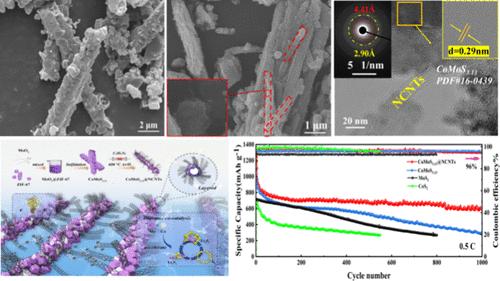当前位置:
X-MOL 学术
›
ACS Sustain. Chem. Eng.
›
论文详情
Our official English website, www.x-mol.net, welcomes your feedback! (Note: you will need to create a separate account there.)
Layered CoMoS3.13@NCNTs with a Rod-Shaped Skeleton as the Cathode of Lithium–Sulfur Batteries
ACS Sustainable Chemistry & Engineering ( IF 7.1 ) Pub Date : 2024-06-21 , DOI: 10.1021/acssuschemeng.4c02312 Jiongfan Wang 1 , Xin Chen 1 , Lingling Chen 1 , Aihua Jiang 1 , Yaping Zeng 1 , Xinyu Li 1 , Jianrong Xiao 1, 2
ACS Sustainable Chemistry & Engineering ( IF 7.1 ) Pub Date : 2024-06-21 , DOI: 10.1021/acssuschemeng.4c02312 Jiongfan Wang 1 , Xin Chen 1 , Lingling Chen 1 , Aihua Jiang 1 , Yaping Zeng 1 , Xinyu Li 1 , Jianrong Xiao 1, 2
Affiliation

|
Lithium metal has considerable advantages as an anode for lithium–sulfur batteries (LSBs). However, LSBs are susceptible to the slow oxidation kinetics of the intermediate product polysulfides (LIPSs) and the tendency of lithium anodes to form lithium dendrites during charging and discharging. Herein, we constructed a porous rod-like skeleton with a metal–organic framework (MOF) as the main template to construct LSB cathodes. ZIF-67 was loaded onto MoO3 nanorods and vulcanized to form a CoMoS3.13 rod skeleton. Melamine was applied as an auxiliary carbon source to generate highly conductive carbon nanotubes, yielding the final hierarchical composites of CoMoS3.13@NCNTs. The unique layered hollow structure of the hierarchical composite CoMoS3.13@NCNTs, which resulted from the excellent exchange synergistic effect of bimetallic ions, exerts good physical constraints and accelerates the transfer and transformation of LIPSs. On the basis of the above advantages, CoMoS3.13@NCNTs showed excellent electrochemical performance when tested as the cathode material for LSBs, possessing an initial discharge specific capacity of 1372 mAh g–1 at 0.1 C and maintaining a low decay rate of 0.039% after 1000 cycles at 0.5 C. CoMoS3.13@NCNTs were also found to have an initial discharge specific capacity of 1372 mAh g–1 at 0.1 C and maintained a low attenuation rate of 0.039% after 1000 cycles at 0.5 C. They had a discharge specific capacity of 643 mAh g–1 after 120 cycles at 0.2 C under a high sulfur loading of 4.0 mg cm–2. This work provides a feasible concept for the preparation of cathode sulfur host materials for high-performance LSBs.
中文翻译:

具有棒状骨架的层状CoMoS3.13@NCNT作为锂硫电池的阴极
锂金属作为锂硫电池(LSB)的阳极具有相当大的优势。然而,LSB 容易受到中间产物多硫化物 (LIPS) 的缓慢氧化动力学以及锂阳极在充电和放电过程中形成锂枝晶的倾向的影响。在此,我们构建了一种以金属有机骨架(MOF)为主要模板的多孔棒状骨架来构建LSB阴极。将ZIF-67负载到MoO 3 纳米棒上并硫化形成CoMoS 3.13 棒骨架。三聚氰胺被用作辅助碳源来生成高导电碳纳米管,产生最终的 CoMoS 3.13 @NCNTs 分层复合材料。多级复合CoMoS 3.13 @NCNTs独特的层状中空结构,源于双金属离子优异的交换协同效应,发挥了良好的物理约束作用,加速了LIPSs的转移和转化。基于上述优点,CoMoS 3.13 @NCNTs作为LSB正极材料测试时表现出优异的电化学性能,在0.1倍率下首次放电比容量为1372 mAh g –1 C,并在 0.5 C 下循环 1000 次后保持 0.039% 的低衰减率。 CoMoS 3.13 @NCNTs 还被发现在 0.1 C 下具有 1372 mAh g –1 的初始放电比容量C,在0.5 C下循环1000次后仍保持0.039%的低衰减率。在4.0 mg cm的高硫负载量下,在0.2 C下循环120次后,其放电比容量为643 mAh g –1 < b9> 。这项工作为高性能LSB的阴极硫主体材料的制备提供了可行的概念。
更新日期:2024-06-21
中文翻译:

具有棒状骨架的层状CoMoS3.13@NCNT作为锂硫电池的阴极
锂金属作为锂硫电池(LSB)的阳极具有相当大的优势。然而,LSB 容易受到中间产物多硫化物 (LIPS) 的缓慢氧化动力学以及锂阳极在充电和放电过程中形成锂枝晶的倾向的影响。在此,我们构建了一种以金属有机骨架(MOF)为主要模板的多孔棒状骨架来构建LSB阴极。将ZIF-67负载到MoO 3 纳米棒上并硫化形成CoMoS 3.13 棒骨架。三聚氰胺被用作辅助碳源来生成高导电碳纳米管,产生最终的 CoMoS 3.13 @NCNTs 分层复合材料。多级复合CoMoS 3.13 @NCNTs独特的层状中空结构,源于双金属离子优异的交换协同效应,发挥了良好的物理约束作用,加速了LIPSs的转移和转化。基于上述优点,CoMoS 3.13 @NCNTs作为LSB正极材料测试时表现出优异的电化学性能,在0.1倍率下首次放电比容量为1372 mAh g –1 C,并在 0.5 C 下循环 1000 次后保持 0.039% 的低衰减率。 CoMoS 3.13 @NCNTs 还被发现在 0.1 C 下具有 1372 mAh g –1 的初始放电比容量C,在0.5 C下循环1000次后仍保持0.039%的低衰减率。在4.0 mg cm的高硫负载量下,在0.2 C下循环120次后,其放电比容量为643 mAh g –1 < b9> 。这项工作为高性能LSB的阴极硫主体材料的制备提供了可行的概念。
















































 京公网安备 11010802027423号
京公网安备 11010802027423号